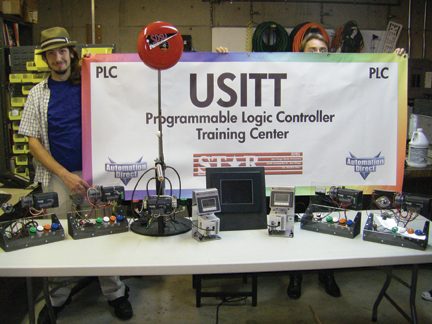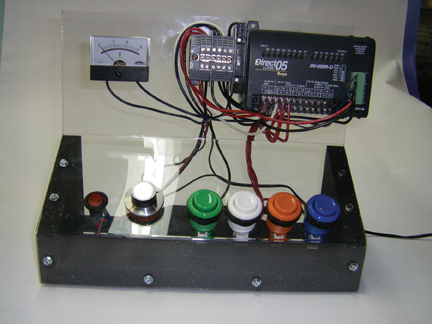PLC training at the United States Institute for Theatre Technology Annual Conference and Stage Expo.
PLC’s are the Star of the Show
AutomationDirect’s programmable logic controllers were featured in a training center hosted by the United States Institute for Theatre Technology (USITT) at their annual Conference and Stage Expo held in Long Beach, California, this spring. The training center was equipped with C-more Micro touch screens and both DirectLOGIC DL05 controllers and CLICK PLCs.
Automation is no longer just for the factory floor. The entertainment industry has also harnessed the latest generation of automation controllers’ incredible power to make graceful scene changes possible with the press of a single button. From cats flying into the heavens on giant Michelins, Spiderman chasing super-villains over audiences on Broadway, to the incredible effects-driven Las Vegas shows such as “O” and “KA,” automation devices have become indispensable to theatrical productions at every level.
Recognizing that training is key to safety in automation, USITT solicited the help of the San Diego State University School of Theatre, Television, and Film—one of a handful of schools with a formal program in theatrical automation—to set up the training center at Stage Expo
AutomationDirect’s price advantage and outstanding service made them the PLC vendor of choice. Students assembled four DL05 stations, each demonstrating a different automation concept. One station used a proximity switch reading the teeth of a motor-driven sprocket to illustrate the use of counters. The second used pulsed outputs to drive a stepper motor. The third station was equipped with an F0-2AD2DA-2 analog module which demonstrated input and output of continuously variable data, while the fourth was used to read the output of an incremental encoder and display results on an 8-inch C-more color touch screen.
CLICK PLCs were used more whimsically. Students were assigned in pairs to create machines of their choosing, which the CLICKs would control. Each machine was required to incorporate the C-more Micro touch screens while demonstrating the use of timers and counters. One team built a ping pong ball air cannon with CLICK-controlled azimuth and elevation, countdown timer and valve trigger all initiated by a retro-reflective beam detector. This proved to be the most popular machine, with trainees attempting to pummel each other with ping pong balls.
The second team built a machine which, when activated by pressing a green GO button, simply turned itself off by extending a pneumatic finger to press a red STOP button. Every third or so attempt to turn itself off was programmed to fail and the finger would have to bump the STOP button several times in frustration before shutting down.
Another machine consisted of a DirectLOGIC DL-05 PLC connected to a pneumatic bell. At the push of a button, a pneumatic claw reached up to pull a plastic ball down against a spring. Once in the cocked position, a second pneumatic cylinder pulled the claw back, launching the ball to strike the bell; because the bell was VERY loud, this machine became very annoying.
The final machine was a simple electronic piano played with pneumatic fingers. A slight miscalculation in the length of the fingers gave a whole new meaning to piano as a percussion instrument; it eventually beat itself to death.
At each of the stations, trainees were shown the ease of ladder logic and stage programming. Most participants were astounded at how easy it was to build a useful program with simple diagrams. The limited version of the DirectLOGIC software and the completely free CLICK software are both available for download from the AutomationDirect Web site.
Having practical applications and animated devices as part of the training center made for a very exciting exhibit visited by scores of conference attendees. USITT would like to thank AutomationDirect for making the training center possible.
Loren Schrieber, Professor
School of Theatre, Television, and Film
San Diego State University
Disclaimer: AutomationDirect does not guarantee the products described in this article are suitable for your particular application, nor do we assume any responsibility for your product/system design, installation, or operation.
Originally Posted: June 1, 2012




